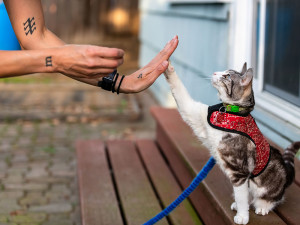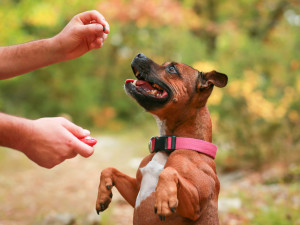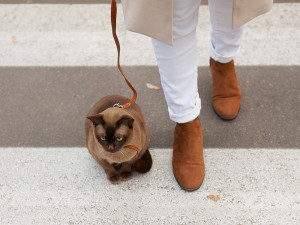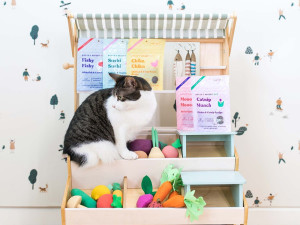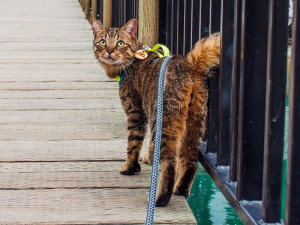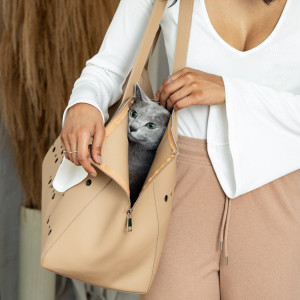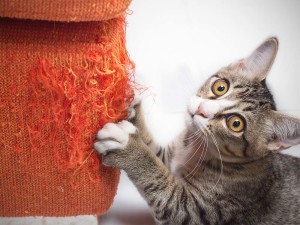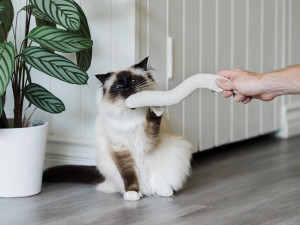How to Train a Cat
Move over, pups. This is a cat’s game, too.
Dogs made the game of fetch famous, but they are not the only ones who play it. Many cats are natural retrievers, benefitting from what this activity has to offer — physical and mental exercise, better connection with their pet parents, relief from boredom, and tons of fun, too. What if you want your cat to play fetch, but they don’t seem to know how? Can you really teach your cat to play fetch? Yes, absolutely you can! With this step-by-step approach, you can train your cat to play fetch and learn many valuable training tips, too.
How to train cats
Training a cat requires patience and a positive approach. Cats don’t respond well to being pushed or forced into doing anything, and that won’t get you what you want, anyway. Avoiding all kinds of pressure or force is wise when training any animal, but harsh methods are especially ineffective and hard on relationships when working with cats. It’s far better — more fun and effective, easier, faster, and free of damage to your relationship — to use positive reinforcement.
What to know/expect
Training progress is rarely steady. Expect to move forward in fits and starts with some plateaus and some periods of rapid advances. Some cats may initiate games of fetch really early on in the training process, and others may take a long time to understand what the goal is. Consider the unpredictability of your cat’s behavior a natural part of training and enjoy any surprises as they come along.
Training your cat is supposed to be fun, and that is especially true when you are teaching them how to play a game. Learning together with the eventual goal of playing fetch is good for you both, and good for your relationship. Expect to have a good time, and treat the training as fun time together to get as much out of the experience as possible.
How much do you spend on your pet per year?
Training methods
The preferred training method is positive reinforcement, which means that whenever your cat does what you want them to do, you give them something they like so they learn that a particular behavior leads to good things. If they learn that, they are more likely to perform the desired behavior. In most cases, this means giving your cat treats for good behavior.
The best way to train a cat to perform any behavior, including fetch, using positive reinforcement is to use clicker training. Once a cat knows that the “click” sound means they did something right and will get a treat for it, the possibilities are endless. You can gradually raise the bar for what the cat must do to earn that click and the treat and guide their behavior in all kinds of exciting ways.
Training basics
The basics of cat training involve keeping it fun, using a clicker and treats, and setting your cat up for success. To help your cat learn to fetch (or any other skill), train in an area with as few distractions as possible at the beginning, and only gradually increase the level of distractions you expect your cat to handle.
Another aspect of training that must be gradual is the level of skill you expect from your cat. At first, it’s a big deal if your cat even pays attention to the toy or gently touches it. Over time, you can expect your cat to grab the toy with their mouth and bring it back to you, but that is at the end of many other steps between the start and that goal.
How to teach a cat to fetch
To teach a cat to fetch, use the clicker to shape your cat’s behavior. “Shaping” means you reinforce successive approximations of the behavior you want. Reinforcing behavior that is closer to the behavior you want at the end of training allows your cat to have lots of success (treats!) throughout the training process and get better and better until they are performing the complete behavior. The key to training a cat to fetch is figuring out the specific steps to reinforce over the course of many training sessions. Here’s how you get started.
Step-by-step guide
Start by choosing your cat’s favorite toy. It doesn’t have to be a ball. Pick whatever toy your cat is most likely to be interested in. Once you have chosen the toy, you are ready to begin shaping your cat’s behavior by clicking and treating successive approximations of fetching. Each training session should last no more than a few minutes and may be as brief as 30 seconds. In each session, aim for three to eight successes at the step you are working on and try to end on a good note when your cat has done a good job. Resist the urge to continue just because things are going well.
Click-and-treat for any contact your cat makes with the toy when you put it within six inches of their nose.
Click-and-treat for open mouth contact by your cat on the toy.
Click-and-treat for grabbing the toy with their mouth.
Roll the ball (or toss the toy), then click-and-treat for any contact with it.
Roll the ball (or toss the toy), then click-and-treat for contact with the mouth on the ball (or toy).
Roll the ball (or toss the toy), then click-and-treat for grabbing the ball (or toy) with their mouth.
Roll the ball (or toss the toy), then click-and-treat for holding it longer.
Roll the ball (or toss the toy), then click-and-treat for heading in your general direction with it.
Roll the ball (or toss the toy), then click-and-treat for bringing it closer to you than before.
Roll the ball (or toss the toy), then click-and-treat for bringing it back to you.
Roll the ball (or toss the toy), then click-and-treat for releasing it near you.
Sometimes, throw the toy after they release it so continuing to play the game is the reinforcer, but in that case don’t click-and-treat — just toss the toy again.
Play fetch with your cat, sometimes throwing the toy again after a good retrieve and sometimes clicking-and-treating after your cat returns the toy to you.
Training tips
To make training your cat to fetch (or to do any other trained behavior) easier, training tips from the pros are always helpful. Have training sessions when your cat is a little hungry (meaning not right after meals!), is focused, and seems interested in being around you. If your cat is distracted or has just eaten or wants some time alone and in peace, it’s not the right time for training.
It’s easier to train a cat to fetch if you work on this skill during their most energetic, playful time of day. Minimize distractions by training in a calm, quiet place and in a room without other cats or dogs. Keep training sessions short, but have multiple sessions each day. “Short” is shorter than most people think. Trainers often work with a cat for 30 seconds to a few minutes at a time.
To keep your cat as interested as possible in the toy and any treats you are offering, use one of their favorite toys and the best treats possible — your cat’s favorite treat is the one that should be used in training. Try rubbing the treat on the toy to increase your cat’s interest in it.
Once your cat can fetch, keep the sessions very short. Sometimes toss the ball two to three times and then stop. If you leave them wanting more, they are more likely to be motivated to play for longer sessions in the future. It’s important to make training fun, so remember that it should never feel like a chore to either one of you. Training is recreational time spent with your cat, and the best training tip of all is for both of you to enjoy it.
FAQs
Are cats easy to train?
With positive reinforcement and lots of patience, cats are far easier to train than most people think. They certainly do not deserve their reputation as untrainable.
How do you train a cat not to do something?
It’s easier to train a cat to do something than not to do something, so if a cat is doing something you don’t like, decide what you want them to do instead and train them to do that.
How long does it take to house train a cat?
Most kittens take to using a litter box quickly and easily within days, though some cats need three or four weeks to learn their house training lessons.
What is the best age to train a cat?
The best age to train a cat is whatever age they are right now. Start training your cat as soon as you welcome them into your life, and keep training them. It’s never too late or too early.


